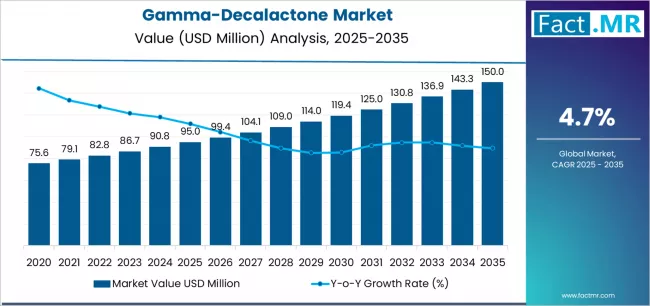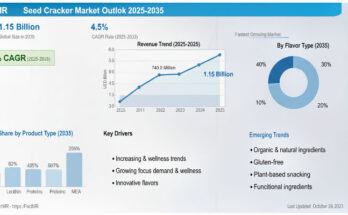As the demand for natural flavoring agents continues to rise, the gamma-decalactone market is gaining prominence across the global flavor and fragrance landscape. Known for its sweet, peach-like aroma, gamma-decalactone is extensively used in food, beverage, cosmetic, and personal care formulations. The ingredient’s versatility and natural origin make it an essential component for manufacturers seeking to enhance sensory appeal while aligning with clean-label and sustainability trends.
With the shift toward natural and plant-based ingredients, the market for gamma-decalactone is experiencing consistent expansion. Its growing applications across multiple end-use sectors, coupled with regulatory support for natural flavoring substances, are steering the market toward a robust growth trajectory over the next decade.
Market Overview
Gamma-decalactone is a naturally occurring compound primarily derived from the oxidation of fatty acids in fruits such as peaches, apricots, and strawberries. It is widely valued for its distinctive fruity scent and smooth flavor profile. In industrial applications, it can also be synthesized through bio-based or chemical processes depending on the end-user preference for natural or synthetic variants.
The market is being propelled by the rising global inclination toward natural ingredients in flavoring systems and fragrances. Consumers today are more conscious about ingredient transparency and are increasingly opting for naturally derived compounds over artificial additives. This shift has led major flavor and fragrance companies to invest in research and production methods that ensure both purity and sustainability.
Furthermore, technological advancements in biotechnological synthesis are redefining how gamma-decalactone is produced. Manufacturers are focusing on fermentation-based methods that enhance yield efficiency while reducing environmental impact, making production more cost-effective and eco-friendly.
Regional Insights
North America holds a leading position in the gamma-decalactone market, driven by a strong demand for natural and clean-label food ingredients. The region’s well-established flavor and fragrance industry continues to invest in advanced extraction and bio-manufacturing techniques, supporting widespread adoption across beverages, bakery, and confectionery applications.
Europe remains a vital market, underpinned by stringent regulatory frameworks promoting the use of natural and safe ingredients. Growing awareness around sustainable sourcing and the region’s robust food manufacturing sector are accelerating demand for gamma-decalactone in both flavoring and fragrance formulations.
Asia-Pacific is emerging as a dynamic growth hub, supported by a rapidly expanding food and beverage industry and evolving consumer preferences for natural flavor enhancers. The rise in disposable income and urbanization across key markets like China, India, and Japan is driving the incorporation of fruity flavor notes in packaged foods, beverages, and personal care products.
Meanwhile, Latin America and the Middle East & Africa are witnessing gradual growth, fueled by increasing exposure to Western food trends and a rising focus on premium and natural ingredients in the cosmetics and food sectors.
Key Trends & Forecast
The gamma-decalactone market is being shaped by evolving trends that reflect the global shift toward natural innovation, sustainable production, and enhanced sensory experiences. Some of the key trends include:
- Clean-Label and Natural Ingredient Demand: Growing consumer interest in minimally processed and naturally sourced compounds is driving manufacturers to replace synthetic flavorings with gamma-decalactone derived from natural fermentation or fruit extracts.
- Expansion in Fragrance Applications: Beyond its use in foods, gamma-decalactone is finding increasing application in perfumes, body lotions, and personal care products, offering a natural, fruity top note that appeals to younger demographics.
- Sustainable Production Practices: The adoption of green chemistry and biotechnological processes is becoming a key competitive advantage for manufacturers seeking to minimize carbon footprints and optimize yield.
- Innovation in Food and Beverage Formulations: The compound’s ability to enhance fruity and creamy notes is being leveraged in dairy products, confectionery, alcoholic beverages, and plant-based alternatives.
- Regulatory Alignment and Safety Assurance: Ongoing efforts to standardize natural flavoring regulations across regions are ensuring consistent quality and safety in gamma-decalactone applications.
These trends collectively point toward a market that is innovating not only in formulation science but also in ethical and sustainable sourcing practices.
Applications & End-Use Outlook
The application spectrum of gamma-decalactone spans across several industries, each leveraging its unique sensory characteristics:
- Food and Beverages: The compound is used extensively in fruit-flavored drinks, desserts, yogurts, and candies to impart a peach-like, creamy aroma. Its compatibility with both natural and synthetic flavor systems enhances its utility in various product formulations.
- Fragrance and Personal Care: In cosmetics, perfumes, and skincare products, gamma-decalactone delivers a refreshing, soft fruity note that adds a natural allure to end products. Its gentle profile makes it ideal for use in lotions, soaps, and shampoos.
- Pharmaceuticals and Nutraceuticals: The pleasant taste and aroma of gamma-decalactone improve the sensory profile of oral formulations, enhancing consumer acceptance.
- Animal Feed and Pet Food: As manufacturers aim to improve palatability, the compound’s mild, fruity aroma is being explored in premium pet food formulations.
The growing diversification of end-use applications is positioning gamma-decalactone as an indispensable ingredient for industries that value both sensory innovation and sustainability.
Challenges and Opportunities
While the market outlook is promising, several challenges persist. The high cost of natural extraction, coupled with supply chain limitations for raw materials, often impacts production economics. Moreover, ensuring consistent quality and purity across production batches remains a critical requirement, especially for applications in the food and fragrance industries.
However, these challenges are being addressed through technological advancements in microbial fermentation and enzyme catalysis, which enable scalable and cost-efficient production. Strategic collaborations between biotech firms, flavor houses, and food manufacturers are also opening new avenues for innovation and product differentiation.
As the focus on sustainability, traceability, and ethical sourcing intensifies, companies that align with these principles are likely to gain a competitive edge in the coming years.
Conclusion
The gamma-decalactone market is at the intersection of flavor innovation and sustainable chemistry. As industries transition toward cleaner, nature-inspired formulations, the compound’s unique sensory profile and eco-friendly production potential make it a cornerstone for the future of natural flavor and fragrance development.
Its expanding presence across food, beverage, and personal care applications reflects a broader industry transformation—one where authenticity, transparency, and sensory quality define market success. For stakeholders, continuous investment in green technologies, R&D, and responsible sourcing will be key to capturing opportunities in this evolving market landscape.
Browse Full Report – https://www.factmr.com/report/4152/gamma-decalactone-market



